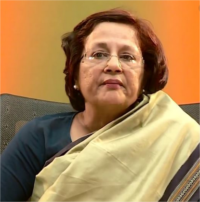
Dr Meenakshi Jain is a noted historian of medieval and colonial India. She is a former Associate Professor of history at Gargi College, University of Delhi, former Fellow of the Nehru Memorial Museum and Library, and former member of the Governing Council of Indian Council of Historical Research. She is currently Senior Fellow of the Indian Council of Social Science Research. Her areas of research include cultural and religious developments in medieval and early modern India. Her deeply researched books have dealt with historical issues of national importance: Flight of Deities and Rebirth of Temples (2019), The Battle for Rama: Case of the temple at Ayodhya (2017), Sati: Evangelicals, Baptist Missionaries and the changing Colonial Discourse (2016), Rama and Ayodhya (2013), Parallel Pathways: Essays on Hindu–Muslim Relations (1707-1857) (2010). She also co-edited The India They Saw: Foreign accounts of India from the 8th to mid-19th century, 3 Vols (2011).
In 2020, Dr Meenakshi Jain received from the Government of India the Padma Shri award, in recognition of her contributions.
Abstract of the lectures: “Traditions of Image Worship in Indian civilization” and “Safeguarding Icons and Temples in Indian history: a pan-Indian enterprise”
The first lecture will first trace the origins of image worship and the importance of icons in India’s civilizational heritage. The earliest archaeological evidence of image worship and temples date to some centuries before the Common Era, from areas as far apart as present-day Madhya Pradesh, Rajasthan, and Mathura. Fragments of epigraphs obtained from these sites suggest that their patrons were individuals who acted in their personal capacity. The unmistakable links between archaeological / epigraphic evidence and literary traditions provide fascinating insights into the evolving tradition of images and temples.
The second lecture will focus on the deep reverence for icons and the extraordinary efforts devotees made to safeguard them over centuries. Their endeavours are documented in the rich genre of temple mahatmyas, epigraphs, dynastic chronicles, and in several cases the accounts of foreign travellers to the land.
Also worthy of examination were the repeated endeavours to reconstruct demolished temples over the centuries even in the absence of state power and patronage. The examples begin in Multan (Sindh) and can be found all the way to Kerala.
Together, these two lectures, resting on the best archival material, will throw much light on a neglected chapter of Indian history.